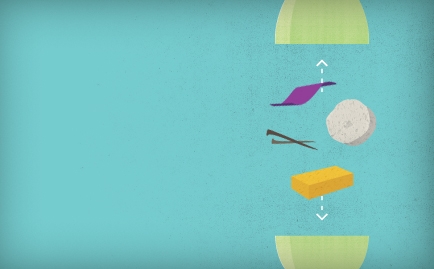
If you grew up going to church, no doubt there’s at least one photograph of you as a child on Easter morning. In that picture, chances are you’re dressed to the nines in something uncomfortable and/or gaudy—a polyester suit, perhaps, or something pink or yellow with more ruffles than a high school prom in the ’70s. Your parents probably put a good amount of thought into that outfit—from the paisley tie to the cutest little pair of white sandals—every detail thought and rethought in hopes that members of your church would ooh and ahh over how adorable you appeared. As odd as that might seem, for many of us, that was what Easter was all about—a Sunday that required a special shopping trip, a lecture from our parents about behaving during the church’s Easter cantata, and then a big choice between whether to eat ham or lamb at lunch. Sure, Easter was about Jesus, but it was also about looking as cute as button, a day that required us to pay attention to the holy as well as the fashionably correct. And even if you grew out of those traditions, you likely aren’t quite sure what you’re supposed to do anymore to observe this sacred day. We love Easter and at the same time are uncomfortable with it. We know it’s a very important day, yet we have trouble figuring out how to celebrate it. What is it about Easter that brings out our “Christian crazy”?
Now, maybe that’s not entirely our fault. Maybe our affection for creating church pageantry—filling vases with stargazer lilies, wearing robin’s egg blue and donning a man dressed up like “Jesus” with enough fake blood to supply a second Scream movies—is just something that happens to us when we become Christian. You know, like sanctification or believing the band Skillet totally rocks.
Or maybe our “Christian crazy” shines more brightly at Easter because it’s the Super Bowl of Christian holidays. And also because Christianity really needs Easter. Think about it: Without Jesus’ resurrection, Christianity would still be Judaism or, at some churches, a Tony Robbins seminar. The belief that Jesus is alive and well and sitting in Heaven at God’s right side is what separates our good deeds from the good deeds of Buddhists and distinguishes our Easter from the “Easter” Martha Stewart celebrates. So perhaps becoming overly excited and fully capable of going a little overboard in our attempt to bring to life the death, burial and resurrection of Jesus is just something we can’t help.
That might explain Resurrection Eggs—you know, the holy dozen of yolkless plastic eggs you can only buy in the springtime at Christian bookstores. Unlike the godless sugary contents of the eggs the Easter bunny lays, each one of God’s pastel eggs contains a small religious item like a purple cloth, a tiny thorn, a sponge and a small rock that, if you’re so inclined, you can roll away. Many Sunday school teachers use Resurrection Eggs because their contents help to remind little ones of the true reason for the resurrection season. And some use the holy eggs to warn their young, impressionable flocks that the Easter bunny is little more than Satan’s plush toy. Either way, using a combo of Christ and bunny to emphasize Easter’s holy message sends a rather mixed message and, to many, is just plain weird.
Truth Is Stranger than Fiction?
Adam Ellis, a Church of Christ pastor in South Carolina, has a theory as to why Easter can sometimes accentuate our strangeness. “I think it’s because the story of Easter is strange,” the 34-year-old says. “Let’s face it: The very idea of a man, one we believe was God, sacrificing Himself on a cross and then resurrecting three days later is weird. It’s illogical. While I believe it, I have to admit it’s unbelievable. There’s no getting around that.” However, Ellis says that just because the story of Christ possesses many strange threads, its oddities aren’t an excuse for us to sensationalize it or retell it any way we see fit. “We should handle God’s story with grace and care,” Ellis says. “Because more often than not, it’s not the weirdness of the resurrection story that pushes people away; people are pushed away by our sad little attempts to take an impractical story and make it practical or applicable to every single detail of our lives. And if we’re honest, that’s truly odd, and in a lot of ways, misses the point of what Easter is about.”
Maybe Ellis is right. All our special effects, smoke and mirrors, choreography and songs fail because it’s impossible to re-create the true miracle of resurrection. But perhaps the bigger travesty to the Easter story happens when we try to reduce the unbelievable parts of the story into short, catchy, simple life applications. When the miraculous is taken out of the story—either by a song and dance that comes with streamers, or when it’s contained in a dozen plastic toy eggs or when pastors diminish it into three sermon points all beginning with the letter “p”—perhaps that’s when Easter becomes just another holiday. A weird one that can be celebrated with bunny-shaped chocolates and shimmery green grass. But that’s not what we want, right?
Even if our church isn’t the kind that reproduces the resurrection story with drama, lights and a pulley, we still have a desire to “see” the story of Jesus come to life. That’s because, for a lot of us, Easter Sunday is like Christmas morning for the soul. Or at least that’s what we want it to be. It’s why many of us go to such crazy lengths to ensure our minds are focused and our hearts open (and praise hands ready!) for Easter—so we don’t miss it. To that end, some of us practice Lent. And some of us quit Facebook for 40 days. Many of us spend time praying and meditating. I know Christians who have traveled to the Holy Land or the Vatican in hopes of “seeing” the story. Heck, Christians in the Philippines strip down to their underwear and let people dressed up like Roman soldiers flog them with whips and hang them on crosses—all in an effort to engage a story they believe has miraculously (and yes, oddly) affected their lives.
While the majority of us would never portray Jesus on a church stage or let a Filipino man dressed as a Roman soldier beat us to a pulp, we do understand the desire to connect with Easter. Furthermore, most of us possess a longing to discover our own role in Jesus’ story; we just hope and pray it’s one that doesn’t come with a costume. Still, isn’t it in finding our role in the Easter story that we experience resurrection? Isn’t that why we find hope in such an odd story—because we believe that somehow the miracle of Jesus’ resurrection brings parts of our own story back to life? Isn’t that the unbelievable grace of Easter?
Perhaps believing in Jesus’ death, burial and resurrection is enough to make anybody seem odd.
Matthew Paul Turner is a blogger and author of Hear No Evil (Waterbrook Press). This article originally appeared in RELEVANT. To read more articles like this, you can subscribe by clicking here.






















